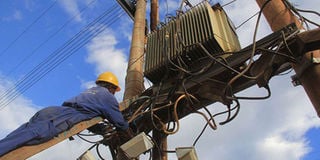To get the country out of energy quagmire, sector needs overhaul

A Kenya Power technician repairs a transformer in Nyeri. PHOTO | FILE | NATION MEDIA GROUP
What you need to know:
Kenya Power was ran as a reasonably efficient entity under the likes of the late Julius Gecau until the early 1980s.
The government owns just over 50 per cent of Kenya Power and to this day has considerable leverage over it.
Even the ERC is supposed to be completely independent of government influence but is not.
When one takes a good hard look at Kenya Power and the energy sector as a whole, one wonders how it even manages to limp along the way it does and still deliver a modicum of a chequered service.
It is important to remind ourselves that power generation and distribution is a vital pillar to the country, its economy and its aspirations to speed up the development of it. If we do not get it right, it will continue to drag us down and help make the ‘Big Four’ agenda a pipe dream.
Whilst Kenya Power is at the forefront of our minds, there are other players: KenGen, Ketraco, Rural Electrification Authority, Geothermal Development Company, Kenya Nuclear Energy Board and, of course, Energy Regulatory Commission.
The tribulations can be detailed under four broad clusters: Institutional, lack of forward planning, the transmission and distribution operation and its complex set of tariffs.
POLITICAL FIEFDOMS
Kenya Power was ran as a reasonably efficient entity under the likes of the late Julius Gecau until the early 1980s. After that, like several other government-run or -controlled institutions, it got captured by the State and its political fiefdoms.
The government owns just over 50 per cent of Kenya Power and to this day has considerable leverage over it. It was managed by Samuel Gichuru from 1984 to 2002 and, for a while, was under the docket of the former Energy minister, the late Nicholas Biwott, from 1982 to 1992. The former is battling an extradition warrant by the Channel island of Jersey over four money laundering transactions during his tenure.
The government also owns 100 per cent of Ketraco, REA, Kneb and GDC and 70 per cent of KenGen and so, to this day, has a tight grip on the sector. Virtually all board appointments are made by the government. Even the ERC is supposed to be completely independent of government influence but is not.
Kenya Power has a flawed planning history. It bases its growth in demand on 15 per cent per annum for the period to 2030 when the actual figure is around six per cent. This is even more absurd than the Vision 2030 figure of 11.5 per cent. For such an entity to get it so completely wrong is wooliness, to say the least.
TRANSFORMER FAILURES
On its transmission and distribution operation, the eyesore at many of its yards are the many faulty or broken-down transformers.
On average, a transformer should last 20 years but rarely get beyond five here. There are around 300 transformer failures a month.
The reason is, Kenya Power has been importing cheap and arguably low-quality transformers from India and China.
They may be the cheapest but they do not meet the required quality standard and specifications.
Even the relatively simple exercise of purchasing electricity poles resulted in Kenya Power paying three times the market price.
BLOATED WORKFORCE
Then there is the claim of a bloated workforce. This is most conspicuous when one sees maintenance and repair work taking place and counts how many of the team appear idle.
What comes out is that Kenya Power has been run more like a family business by its senior management.
It is not surprising that its tariff is higher than what it should be. Last financial year’s tariff, inclusive of all costs, was Sh15.62 per kilowatt hour and it is projected to rise to around Sh17/ kWh this financial year. Bear in mind that there was a government subsidy of around Sh3/kWh in the 2016/17 figure.
The bottom line is, Kenyans are getting poor value for money from Kenya Power and the energy sector as a whole due to poor management and fraud.
The sector needs a dedicated and professional makeover, starting with bringing the managers to book.
TRANSPARENT
An executive review body comprising experienced sector players, representatives from the National Treasury and Energy ministries and private sector stakeholders such as the Kenya Association of Manufacturers should be set up with the objective of making these bodies professional, efficient, transparent and, most important, deliver value for money.
It should also turn them into independent entities delinked from the Ministry of Energy. They are, after all, commercial operations and should be subjected to the relevant benchmarks. The government would be party to the operations but not as the controller.
The fact that these set-ups must balance social responsibilities and considerations with commercial interests goes without saying.
Mr Shaw is an economic and public policy analyst. [email protected].





